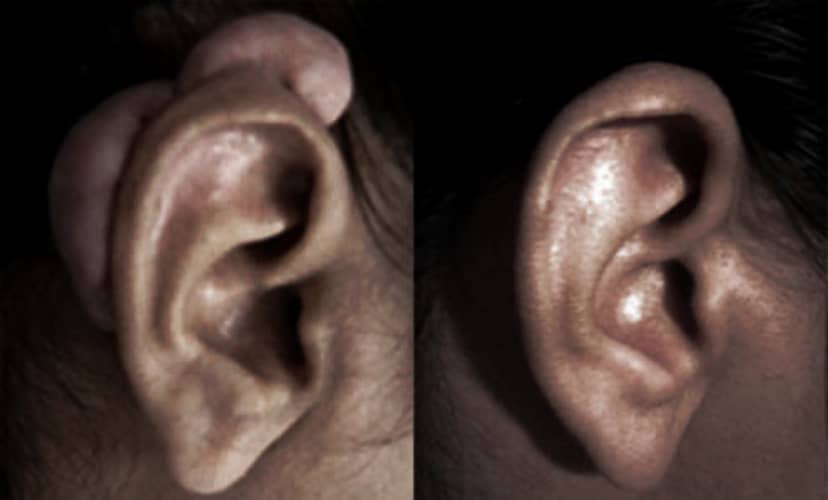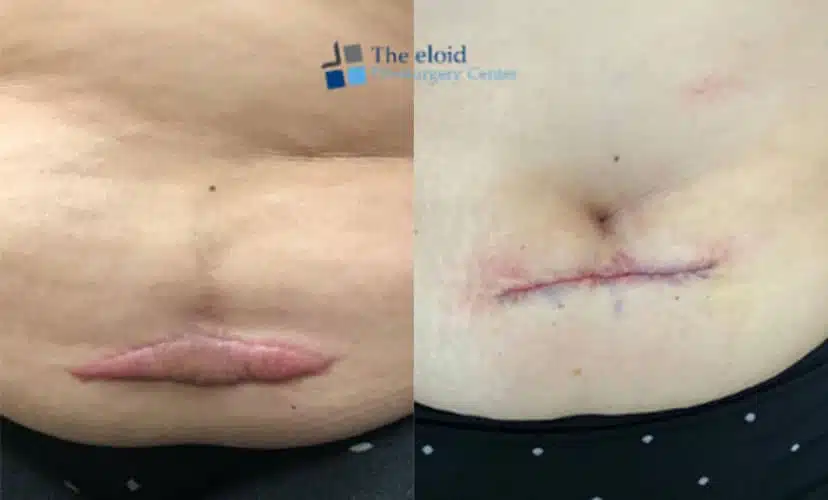Is a keloid making you feel self-conscious or ashamed? At The Keloid Plastic Surgery Center, removing keloids is what we do. Board-certified Reconstructive and Plastic surgeons Dr. Roberto J. Mendez and Dr. Gabriel Salloum are world-renowned experts in keloid and hypertrophic scars who combined have over 40 years of experience treating keloids big and small. Together with their skilled team, they are one of the few practices in the country offering advanced surgical and non-surgical keloid removal options with proven low recurrence rates.

- Benefits of Keloid Surgery in Miami Beach
- Why Does Keloid Scarring Occur?
- How Does a Keloid Look?
- Main Causes of Keloids
- Ideal Candidates for Keloid Removal Surgery
- Keloid Removal with Surgery in Miami Beach, FL
- The Keloid Surgical Removal Procedure
- Keloid Surgery Cost in Miami Beach, FL
- What to Expect After Keloid Removal Surgery
- Recovery from a Keloid Removal Surgery
- Risks of Keloid Removal Surgery
- Frequently Asked Questions about Keloid Removal Surgery
advantages
Benefits of Keloid Surgery in Miami Beach
Experience a new level of confidence with Dr. Mendez and Dr. Salloum. Their keloid surgical removal offers unmatched benefits, combining expert care, safety, and innovative techniques. Enjoy a life free from keloid scar tissue, with a procedure that’s tailored to your unique needs.
Noticeable Size Reduction
Witness the dramatic reduction in keloid size. Our targeted surgical approach effectively removes excess scar tissue, leading to a more aesthetically pleasing skin surface.
Cutting-Edge Surgical Methods
Benefit from our advanced techniques. Dr. Mendez and Dr. Salloum’s expertise in modern surgical methods ensures precision and optimal results in every procedure.
Assured Safety in Treatment
Embrace a safe procedure. Our dedicated team upholds the highest safety standards, providing a secure and effective solution for keloid removal.
Why Does
Why Does Keloid Scarring Occur?
When the deep, thick layer of the skin (dermis) becomes wounded, skin cells react by forming new collagen fibers to repair the damage and close the gaps created by the injury. In turn, these new fibers form scar tissue, resulting in a noticeable scar. A keloid is a type of scar that is formed when the skin produces too much scarring. It usually occurs at the site of a previous skin injury.
Keloids are types of scars that can develop after any surgery like mole removal, and traumatic injuries – including tattoos and body piercings, aesthetic procedures, and so on. Sometimes keloids can show up months or even years after the skin is wounded. On rare occasions, it is also possible for keloids to form on uninjured skin, including on the nose. Some people seem to be more prone to keloidal scar formation than others, especially those with darker skin (African Americans, Hispanics, and Asians), patients younger than 30, and people with a personal or family history of keloids.
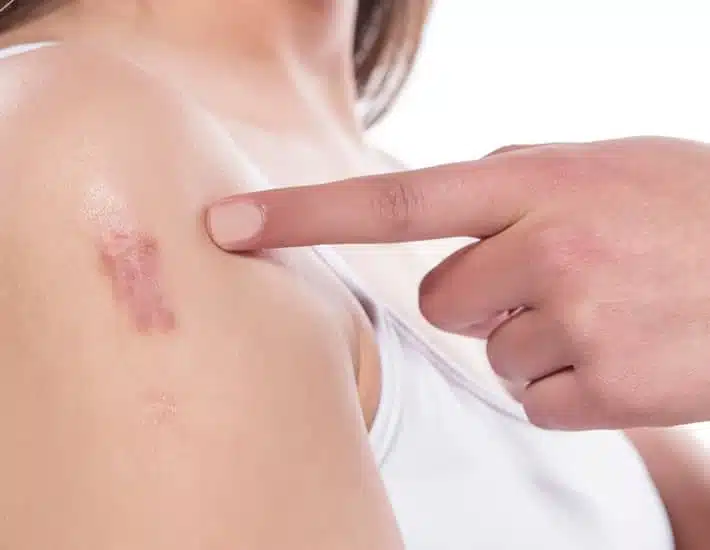
How Does a Keloid Look?
Keloids can have the following characteristics:
- Slow-growing, typically over the course of three months or longer. At times, keloids can continue growing for years
- Begin as raised, bright pink or purple scars that become darker in color with time. Unlike a regular scar, which tends to look pale and flat, once keloids stop growing, they typically end up looking darker than the person’s skin
- Larger in size than the original wound
- Shiny and hairless
- Hard and rubbery to the touch
- Some keloid scars are painless, but others can be itchy, tender, or cause a burning sensation
causes
Main Causes of Keloids
Keloid scars are caused by skin injuries such as the following:
- Surgical incisions
- Cosmetic procedures
- Burns
- Acne scars
- Cuts and scratches
- Ear piercings
- Chickenpox scars
- Tattoos Vaccinations
BEFORE & AFTER GALLERY
Natural & Unparalleled Results
Surgeries performed by renowned plastic surgeon Roberto J. Mendez M.D. and double board-certified plastic surgeon Dr. Gabriel Salloum in Miami Beach, FL

Contact
Schedule A Consultation Today
At the state-of-the-art facility, The Keloid Plastic Surgery Center, our team is dedicated to providing our patients with the expert medical care they need to properly eliminate their keloids and improve the appearance of scars. Contact our office today to schedule a consultation with one of our board-certified plastic surgeons. They provide you with outstanding results from your keloid removal surgery and let you know about the additional skin treatment options we offer to help prevent a recurrence.
Candidates
Ideal Candidates for Keloid Removal Surgery
One in ten people will develop keloids, with men and women experiencing them at equal rates after a traumatic injury. There’s often a genetic component to this condition, making those of darker skin tones, including African American, Hispanic, and Asian descent, more susceptible to keloid formation.
Suppose you have an unsightly keloid scar or a hypertrophic scar that causes discomfort or other issues. In that case, you may be part of the candidates for keloid scar reduction surgery at our office in Miami. During your initial evaluation, we will check your medical history and assess the extent of your keloid scar. Then, we will determine if any other factors could affect your treatment decision. We may recommend non-surgical treatments first, but if these fail, we will offer surgical options.
If you’re an ideal candidate for keloid scar treatments, you need to be realistic about your chances of success. To get a better idea of your chances of success, take a look at our keloid scar photo gallery.
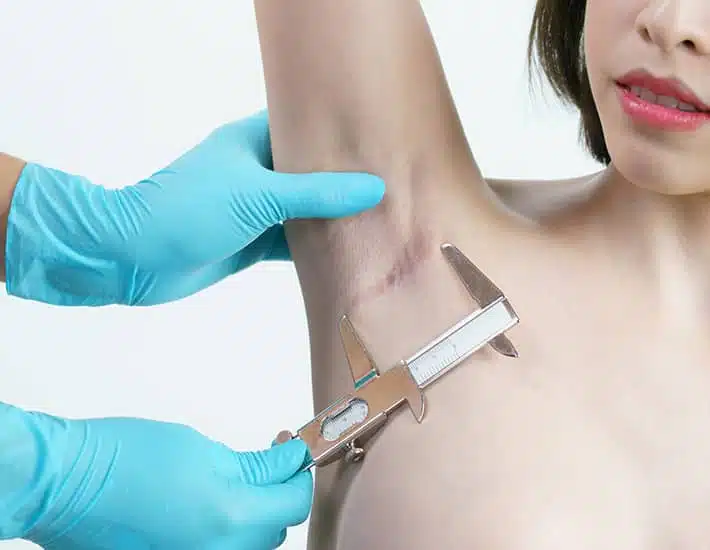
Surgery
Keloid Removal with Surgery in Miami Beach, FL
At the state-of-the-art facility, The Keloid Plastic Surgery Center, our team is dedicated to providing our patients with the expert medical care they need to properly eliminate their keloids and improve the appearance of scars. Contact our office today to schedule a consultation with one of our board-certified plastic surgeons. They provide you with outstanding results from your keloid removal surgery and let you know about the additional keloid removal treatment options we offer to help prevent a recurrence.
The Keloid Surgical Removal Procedure
A plastic surgeon will do a surgical excision to remove the unsightly scars. Afterward, any extra skin that has been pulled back is cut off so that the wound may close up with a flat scar without tension. In many cases, surgery requires only one procedure, unlike laser therapy, which requires many sessions to treat the keloid.
One problem with this modality is its rate of recurrence of keloid scar. It varies from about 50% to 95%, depending on the study that you read. With surgical procedures, some keloid-forming cells may remain in the area, which can lead to keloid recurrence. So, to reduce the chance of keloid growth and avoid scar revision surgery, we encourage patients to undergo additional post-surgical treatments. These treatment options can effectively target and eliminate keloid-forming cells in the treated area after a primary procedure. The combination of skin treatments for a complete resolution can include:
- Superficial radiation therapy (SRT) – performed 24 to 48 hours after keloid removal surgery to lower the chances of a new keloid forming
- Compression therapy
- Corticosteroid injections
- Cryotherapy
- Silicone gel pads

surgery price
Keloid Surgery Cost in Miami Beach, FL
The cost of keloid surgery is influenced by various factors, including the size of the keloid, the complexity of the medical procedures required, and the specific techniques employed. We strive to provide transparent pricing, ensuring that each patient understands the financial aspects of their personalized treatment plan. Our team is dedicated to offering effective solutions, balancing advanced care with cost considerations, to make this vital treatment affordable.
After surgery
What to Expect After Keloid Removal Surgery
Immediately after keloid removal surgery, your doctor will carefully suture the area and cover it with sterile bandages to keep the site clean and protected for healthy skin.
Dr. Mendez and Dr. Salloum use absorbable Stitches most of the time so that there is no need to remove them. Please follow your care team’s instructions to minimize complications. If you have any questions, don’t hesitate to call the office at 1 (833) 453-5643.
Results will be noticeable immediately after surgery, but it may take some time for the area to heal completely. Dr. Mendez and Dr. Salloum of The Keloid Plastic Surgery Center take great care to prevent additional keloids from forming at the surgery site, including performing other postoperative procedures, such as radiation therapy and steroid injections. In addition, they will give you tips for preventing keloid recurrence and achieving permanent keloid removal.
RECOVERY
Recovery from a Keloid Removal Surgery
The keloid removal recovery takes several weeks. During this period, you may experience some swelling and bruising. Your doctor will give you tips to follow during the keloid surgery recovery and prescribe pain medication and antibiotics to help speed healing as well as a topical treatment if necessary.
After the wound heals, you’ll need to wear compression garments to prevent scarring. These garments keep the area moist and reduce friction between the skin and bandages. It is necessary to wear the garment until the stitches dissolve.
Once the stitches dissolve, you’ll need to avoid direct sunlight and use sunscreen daily. This helps prevent sunburn and keeps the area dry. After two months, you can remove the compression garments and resume normal activities.
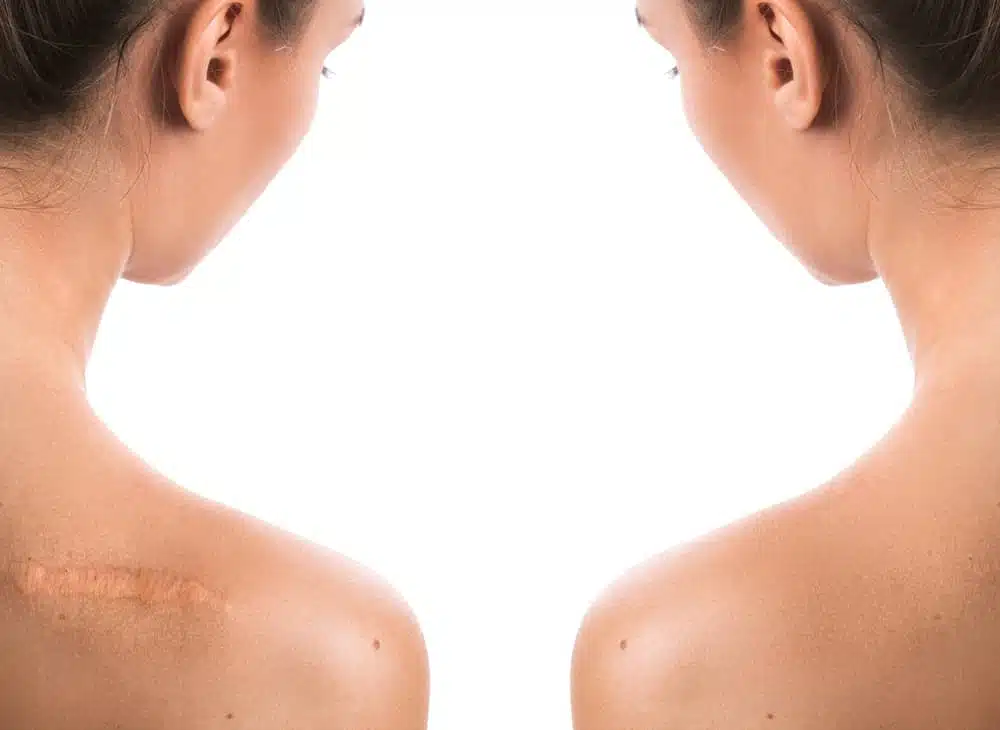
RISKS
Risks of Keloid Removal Surgery
Keloid Scar Removal Surgery is the only effective treatment for keloids. However, there are risk factors associated with this procedure. The most common risk is scarring. Other risks include infection, bleeding, nerve damage, and anesthesia complications. To avoid these possible adverse events you need a keloid expert to help you solve all your doubts about the keloid removal surgery.
If you decide to go through with the surgery for permanent keloid removal, ask your doctor about any possible side effects and risks. Be sure to discuss these issues with him/her beforehand.

TESTIMONIALS
What our Patients say

FAQs
Frequently Asked Questions about Keloid Removal Surgery

Why Choose Plastic Surgeon Dr. Mendez?
- Board certified plastic surgeon for more than 20 years
- Certified by American Board of Plastic Surgery
- Member of the American Society of Plastic Surgeons
- Fellow of the American College of Surgeons
- Graduate of Saint Louis University and Ponce School of Medicine
Why Choose Plastic Surgeon Dr. Salloum?
- Double-board certified plastic surgeon by The American Board of Surgery and The American Board of Plastic Surgery
- Training at Vanderbilt University in Nashville, TN
- Residency at the Mount Sinai Medical Center
- Plastic Surgery Program at the University of Texas at Houston
Last modified by Dr. Gabriel Salloum
